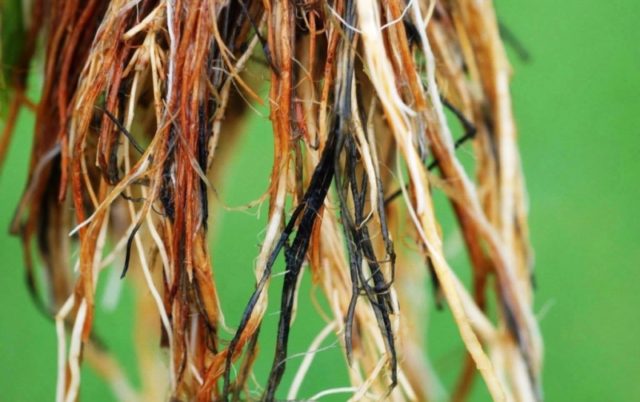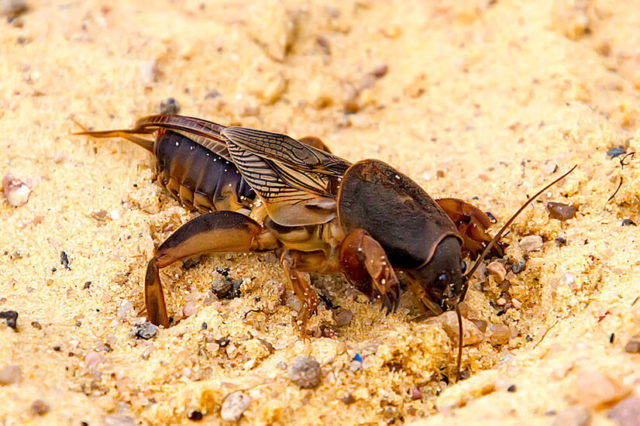Content
The bellflower is a simple but elegant plant with low growing requirements. You can plant a perennial in any garden, and the varietal variety allows you to choose the desired shade of flowering.
Description of the milk-flowered bell
The herbaceous perennial Campanula lactiflora belongs to the Bellflower family and looks like a medium-sized plant with straight branchy stems, brownish-green or with a slight red tint, about 20 pieces. The leaves of the milky-flowered bell are wide, but elongated, slightly toothed, with a pointed end, rough to the touch. In the lower part of the plant, the plates sit on short petioles, and closer to the top, directly on the stem.

Milk-flowered bell bush consists of 20 stems or more
In height, the plant can rise up to 170 cm above the ground. In diameter, it usually spreads half a meter, grows quickly, by mid-July the bushes have already reached their maximum size.
The perennial prefers to grow in well-lit areas with light shading from direct sunlight. In nature, the milk-flowered bell can be found mainly in warm regions, in Asia Minor and the Caucasus. But it also grows in subalpine meadows and mountain forests, tolerates winter temperature drops to -35 ° C, therefore it is suitable for cultivation in the middle zone, in the Urals and in Western Siberia.
Flowering begins in June and can last until early September, especially with the timely removal of wilted buds, they are replaced by new ones. The flowers of the plant are stellate, five-petal, up to 4 cm wide. The photo of the milk-flowered bell shows that the buds are collected in large racemose inflorescences. They can bloom very abundantly in favorable conditions - with moderate moisture, on neutral soil and in good lighting. The range of flowering is determined by the variety, the buds can be white, blue, pale lilac and even two-colored, with a light neck.

Milky-flowered bell can bloom all summer
Milk-flowered bell varieties
Perennial decorative forms are represented by several popular varieties. They are very similar in terms of care requirements, but differ in size and shade of flowering.
Prithards Variety
Prichards Variety produces beautiful blue or delicate lavender flowers. In size, the bushes of the milk-flowered bell are medium-sized, up to 60 cm, the perennial prefers to grow in the sun. It enters the maximum decorative effect in June and can please with inflorescences until autumn.
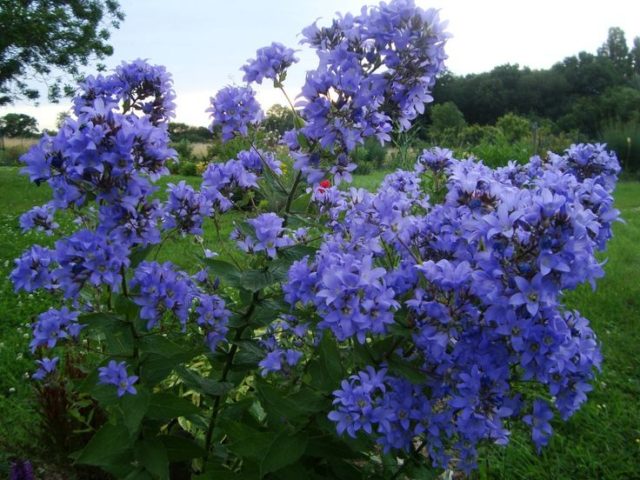
Prithards Variety tolerates winter cold down to -34 ° C
Loddon Anna
The Loddon Anna variety is tall and can stretch up to 125 cm. The flowers of the perennial are pink or light purple, bloom from late May to early September. The diameter of individual buds can be up to 4 cm. The plant is frost-resistant, suitable for growing in zone 4 (up to -34 ° C), does not need shelter.
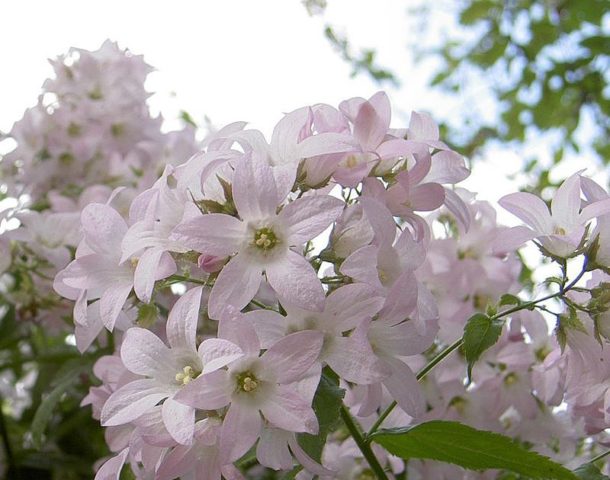
Loddon Anna grows well in lighted areas
Alba
The Alba variety rises up to 80 cm above the ground, is distinguished by a loose silhouette of a bush and abundant snow-white flowering. The buds of the white milk-flowered bell are large, up to 6 cm wide, star-shaped, and they bloom from June to August.
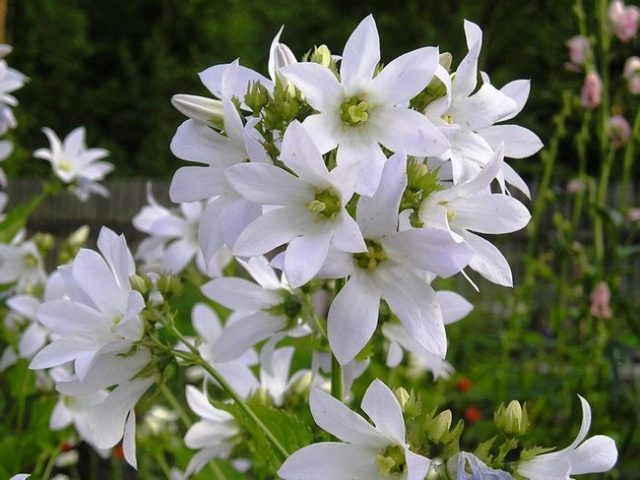
Planting Alba is best in the sun, although the bell grows well in light shade
Superba
The ornamental Superba grows up to 125 cm and forms quite dense shrubs with abundant flowering in June and July. The perennial buds are dark purple, small, only up to 2 cm. The milk-flowered bell grows well on loose nutrient soils in sunny areas, calmly tolerates partial shade and winter cold below -30 ° C.
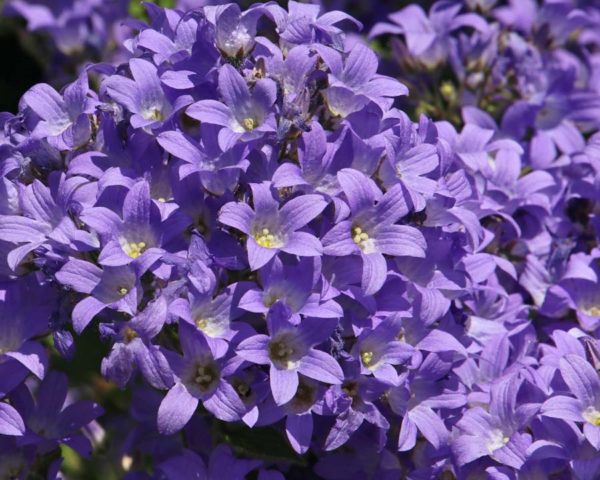
The Superba variety is used for cutting, the thick bright brushes of the bell do not fade for a long time
Cerulea
Cerulea, or Caerulea, reaches a height of 100 cm and blooms from the beginning of June. The flowers are bluish, delicate, with a pleasant light aroma. The variety prefers moderate moisture and grows well in sunny areas with loose soil. For the winter, it requires pruning, but no shelter is needed, and tolerates frosts of about -34 ° C.
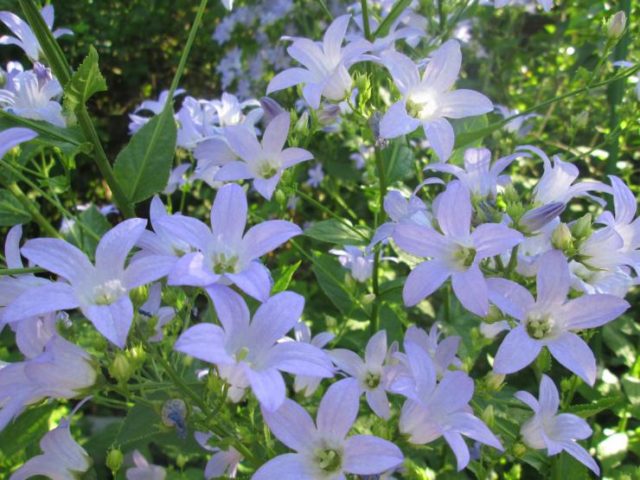
The delicate blue bell of Cerulea looks good in light shade
Poof
Pouffe is a dwarf variety and is great for rocky gardens, alpine slides and container growing. The height of the bush is about 30-40 cm, the flowering of the variety is pale lilac, lasts from June to August. A short perennial tolerates winter well and does not require shelter in frosts below -30 g ° C.

The Pouf variety belongs to the dwarf category - about 20 cm
Application in design
The modest milky-flowered bells look great during the flowering period and are therefore actively used in landscaping. They are planted on the site:
- in rocky compositions;
Lilac and blue flowers of undersized varieties look good in rockeries and alpine hills
- not far from water bodies;
Tall and medium-sized varieties of bells can beautifully decorate the shores
- in art groups with conifers;
Bells look favorably against a background of dense greenery
- when decorating borders.
Low varieties beautifully frame paths in the garden
Bells can grow successfully next to roses, grasses, wildflowers, pansies, daisy, carnations, and other crops. Only moisture-loving plants and trees with a powerful root system are not suitable for them as neighbors. In the first case, the milk-flowered bell will suffer from waterlogging, and in the second it will have to compete for water and nutrients.
Reproduction methods
In the garden, the milk-flowered bell is propagated in the following ways:
- seeds;
- dividing an adult plant by the rhizome;
- cuttings;
- offspring, or young rosettes, developing at some distance from the main stem.
The easiest way to grow a milk-flowered bell is from seeds. When breeding rare varieties, cuttings and offspring are used.
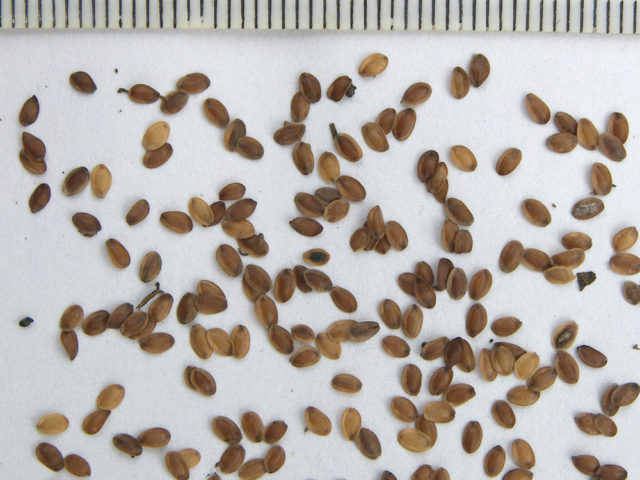
Milky-flowered bell germinates well from seeds
Planting a milk-flowered bell
A perennial plant is very unpretentious and easy to root. It is enough for a gardener to know the basic rules of planting.
Dates and choice of location
It is best to plant the milk-flowered bell in late spring or August. Theoretically, the procedure can be carried out even in the middle of summer, but the beginning and end of the growing season remain optimal.
The site for the plant is chosen open, but with a light shade from buildings or trees. Milk-flowered bell loves light, but grows worse in direct sunlight. The soil for perennials is loose and nutritious, the pH level should be close to neutral.The plant should not be planted in a lowland or near groundwater, it needs high-quality drainage.
Preparation of soil and seedlings
Before planting a milk-flowered bell, the site must be dug up and, if necessary, the soil must be improved. If the soil in the garden is too heavy, it needs to be mixed with humus; on light soils, it is recommended to add sod and compost. Without fail, sand is introduced into the soil, it will provide a good drainage of excess moisture.

When planting several bells, leave space between the bushes
At the chosen place for the plant, small holes are prepared, they should be twice the size of the root system. Drainage from sand or small stones is poured to the bottom, half-fill the hole with prepared soil mixture from above.
Landing algorithm
A couple of hours before planting, the perennial seedling can be briefly lowered into the water by its roots. In the presence of an earthen coma, it is allowed to simply moisten it abundantly. Then you need to:
- put the plant in the prepared recess;
- cover with soil remnants flush with the surface;
- lightly compact the top layer next to the stem.
The seedling must be watered immediately, but carefully, so as not to erode the soil at the base. If several plants are rooting at once, gaps of 30-60 cm should be left between them, depending on the dimensions of a particular variety.
Follow-up care
Caring for milk-flowered bells is extremely simple. The gardener needs to monitor the moisture and cleanliness of the soil, as well as fertilize the plant from time to time.
Watering
A perennial plant requires moisture, but in very moderate amounts. Usually, natural precipitation is enough for herbaceous shrubs; it should be additionally watered only in extreme heat and in the absence of rain.

Watering the milk-flowered bell is rarely necessary, even in hot summer
Top dressing
The milk-flowered bell, which is undemanding to growing conditions, needs fertilization twice a season. In the spring, urea or ammonium nitrate is added to the flowerbed with the plant for the rapid growth of stems and leaves - the dosage should not exceed 40 g per meter. At the beginning of summer, when buds appear, the perennial can be fed with superphosphate and potassium, they will contribute to more abundant flowering.
Mulching and loosening the soil
Milk-flowered bell prefers breathable light soils. After each watering or natural precipitation, the soil in the flowerbed must be carefully loosened to a depth of about 6 cm. The procedure not only improves oxygen access to the roots, but also helps to fight weeds that take away moisture and nutrients from the plant.
It is also recommended to mulch the flower bed with straw or wood chips. This will prevent the soil from drying out in the heat and will also prevent weeds from breaking through to the surface.
Tying to a support
Many varieties of milk-flowered bells rise above 70 cm. During the flowering period, their stems can break under the weight of numerous buds or from the wind. Therefore, tall varieties can be tied to any support.
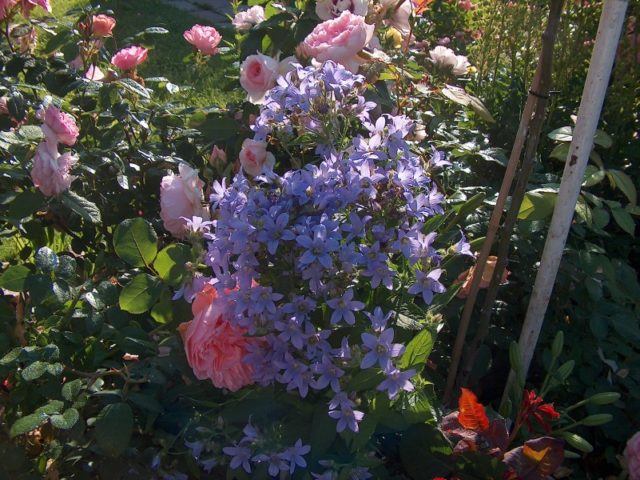
Very tall bell bushes can be tied up if there is a support nearby
Preparing for winter
At the beginning of autumn, the milky-flowered bell finishes flowering. With the onset of October, the stems of the plant are completely cut to the root, the procedure helps the perennial to prepare for winter.
3 weeks before the onset of cold weather, organic fertilizing is applied - the plant is covered with humus or dry peat on top with a layer of 15 cm.In the conditions of the middle zone and even the Urals, such insulation will be enough for the roots, but if you wish, you can throw fallen leaves or spruce branches into the flower bed.
Diseases and pests
Milk-flowered bell has a high natural resistance to fungal diseases.But sometimes he can suffer from diseases, especially during rainy and cloudy summers. Most often he is struck by:
- spotted rust;
Rust leaves ugly brown-red marks on the leaves and leads to wilting
- powdery mildew;
With powdery mildew, a white bloom appears on the green parts, the bell can completely fade
- root rot.
When rot appears, the roots and stems of the bell darken and soften
For the treatment of diseases, Fundazole solution or ordinary copper sulfate is used. If the conditions on the site are unfavorable, it makes sense to carry out preventive treatments three times per season from early spring.
Of the pests for the milk-flowered bell, the following are dangerous:
- slugs;
With high humidity, slugs heavily eat leaves and flowers
- spider mite;
Spider mites can densely entangle the bell with cobwebs, especially if the summer is dry
- bears.
Medvedka actively digs holes in the soil and damages the roots of the bell
To eliminate insects, Karbofos and Actellik are used, and homemade soap solution also helps. For the prevention of pests, it is very important from time to time to loosen the soil in which the larvae and adults are hiding.
Conclusion
The milk-flowered bell is a beautiful and undemanding perennial with high frost resistance. White, blue and purple varieties allow you to choose the most suitable plant for the site.






